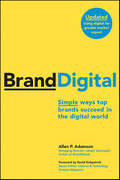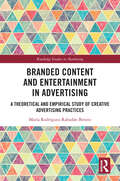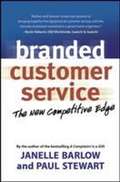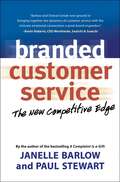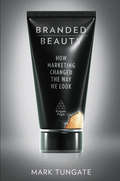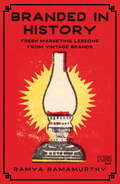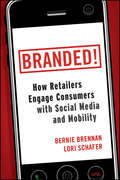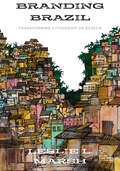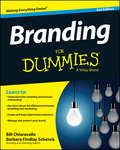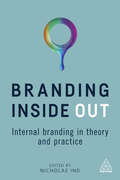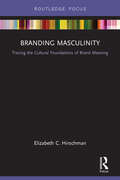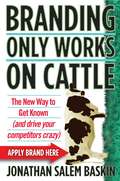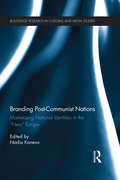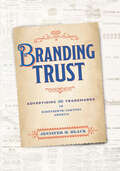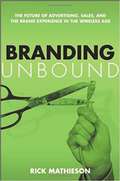- Table View
- List View
BrandDigital: Simple Ways Top Brands Succeed in the Digital World
by Allen P. AdamsonSince the publication of his previous best-selling title, BrandSimple, Allen P. Adamson has studied and worked with companies as they've experimented with and integrated digital initiatives into their branding mix. In his new book, BrandDigtial, he clearly demonstrates that in an environment where everything is transparent, brand professionals have unprecedented opportunities to learn more about their customers, and to deliver brand experiences that meet customer expectations better than ever before. Based on over 100 interviews with leaders in both the branding and digital technology industries, Adamson drives home his point by using case studies and first-hand, in-market examples from companies including Hewlett-Packard, Johnson & Johnson, Procter & Gamble, Nike, Ameriprise, Burger King, PepsiCo, and General Mills. Along with putting into proper context the role Google, YouTube, Second Life, social media, and blogs play in the branding process, Adamson shows how the best companies are taking advantage of evolving digital technology and its associated behavior to build stronger bonds with their customers and stronger, more responsive brands.
BrandJitsu™: Move Your Brand from "Meh" to Memorable
by Michael DargieYour brand is the most important part of your business — it’s a living thing. Learn to find, shape, and share your brand story with the world.Consider this: every individual and business tells a story to the world, and that story is their brand. It’s alive, constantly developing, experienced in real time by everyone around it. Now ask yourself, Are you consciously shaping and broadcasting that brand story? Is it under your diligent care and control, or is it running amok, causing chaos everywhere it goes? Or, perhaps even more tragic, is it sitting in a corner sulking, wondering why no one notices it? BrandJitsu™ is a practical and effective way to strengthen your living brand, like a muscle, so that it tells the story you want it to tell — a meaningful and memorable tale that will not just attract the attention of your ideal customers but also the best employees, partners, and suppliers. Mastering BrandJitsu™ won’t take years. It’s a skill that can be quickly learned and applied as soon as you finish reading this book. It teaches you to sharpen your focus, strategically align your brand’s DNA, and ensure your story is not just heard but felt, leaving a lasting impression on everyone it touches.
BrandPa
by Naga ChokkanathanConoce a Vinay; sus amigos lo llaman BrandPa, a veces de manera burlona, pero en general con asombro en sus ojos. Por supuesto, él es muy joven para que lo llamen GrandPa, pero está muy interesado en marcas, toda clase de marcas antiguas, viejas y nuevas. Sigue a cientos de marcas y mantiene su cerebro actualizado con la información más reciente sobre ellas. Puedes hacerle cualquier pregunta y él te dará una larga (pero no aburrida!) explicación al respecto, con datos e historias jamás antes escuchados! Vinay te encontrará en cada capítulo, con fascinantes, y en su mayoría desconocidos detalles sobre famosas marcas. ¡Utiliza esta oportunidad para aumentar tu CM: Cociente de Marca!
Branded Content and Entertainment in Advertising: A Theoretical and Empirical Study of Creative Advertising Practices (Routledge Studies in Marketing)
by María Rodríguez-Rabadán BenitoIn recent years, branded content and entertainment have become standard practice for brands, advertising agencies, and production companies. This volume analyzes branded content through a theoretical and empirical study to examine the factors that have led to exponential growth and the adaptation of creative advertising processes in the creation of branded content. The book debates the suitability and acceptability of branded entertainment as an advertising practice, the different degrees of involvement of the brand in creating content, and the brands' mastery of entertainment. It explores the implications that may underpin the practice and discusses the necessary creative elements involved in their successful execution, as well as the effects it has on consumers and audiences. This insightful book will be a valuable guide for academics and upper-level students across marketing disciplines, including advertising, brand management and communications, as well as screenwriting.
Branded Customer Service: The New Competitive Edge
by Paul Stewart Janelle BarlowBranded Customer Service shows you how to create a recognizable style of service that reinforces brand promises and brand images, how to link brand propositions to selling style and messages.
Branded Customer Service: The New Competitive Edge
by Paul Stewart Janelle BarlowBranding is an integral part of modern business strategy. But while there are dozens of books on branding products and marketing campaigns, nobody has applied the logic and techniques of branding to customer service -- until now. Branded Customer Service is a practical guide to moving service delivery to a new level so that brand reinforcement occurs every time customers interact with organizational representatives. Janelle Barlow and Paul Stewart show how to infuse an entire organization with brand values and create a recognizable style of service that reflects brand promises and brand images.
Branded Entertainment and Cinema: The Marketisation of Italian Film (Routledge Critical Advertising Studies)
by Gloria DagninoThe history of Italian cinema is mostly regarded as a history of Italian auteurs. This book takes a different standpoint, looking at Italian cinema from the perspective of an unusual, but influential actor: advertisers. From the iconic Vespa scooter and the many other Made in Italy products placed in domestic and international features, to Carosello’s early format of branded entertainment, up through the more recent brand integration cases in award-winning titles like The Great Beauty, the Italian film and advertising industries have frequently and significantly intersected, in ways that remain largely unexplored by academic research. This book contributes to fill this gap, by focusing on the economic and cultural influence that advertising and advertisers’ interests have been exerting on Italian film production between the post-war period and the 2010s. Increasingly market-oriented film policies, ongoing pressure from Hollywood competition, and the abnormal economic as well as political power held by Italian ad-funded broadcasters are among the key points addressed by the book. In addition to a macro-level political economic analysis, the book draws on exclusive interviews with film producers and promotional intermediaries to provide a meso level analysis of the practices and professional cultures of those working at the intersection of Italian film and advertising industries. Providing an in-depth yet clear and accessible overview of the political and economic dynamics driving the Italian media landscape towards unprecedented forms of marketisation, this is a valuable resource for academics and students in the fields of film and media studies, marketing, advertising, and Italian studies.
Branded beauty: how marketing changed the way we look
by Mark TungateBeauty is a multi-billion dollar global industry embracing make-up, skincare, hair care, fragrances, cosmetic surgery - even tattooing and piercing. Over the years it has used flattery, seduction, science and shame to persuade consumers that they'll have to invest if they want to look their best. In Branded Beauty, Mark Tungate delves into the history and evolution of the beauty business. From luxury boutiques in Paris to tattoo parlours in Brooklyn, he talks to the people who've made skin their trade. He analyses the marketing strategies used by those who create and sell beauty products. He visits the labs where researchers seek the key to eternal youth. He compares attitudes to beauty around the world and examines the rise of organic beauty products. Full of fascinating detail on great names such as Rubinstein and Arden, Revlon, Estée Lauder, L'Oréal and Max Factor, Branded Beauty also considers the future of the beauty business.
Branded in History
by Ramya RamamurthyWhat did advertising campaigns look like 100 years ago? How did early brands capture the imagination of Indian consumers? How deep are the roots of modern consumer behaviour in the country?Lux soaps, Jabakusum hair oil, Woodward's Gripe Water, Atlas Cycles, Dalda, Mafatlal Textiles - these evergreen brands have immortalized themselves by capitalizing on emerging trends for almost a hundred years. These popular brands as well as others lesser known (though equally iconic) can teach modern-day brands a thing or two about surviving in a market that is in constant flux.Focusing on a century bookended by two movements for independence, Branded in History draws readers into the fascinating story of how colonial Indian brands - both home-grown and foreign - were produced, distributed and marketed between 1847 and 1947, a time when branding as a concept was still in its infancy.From consumer goods to consumables, household utilities to toiletries, and heavy industries to medical supplies, this book explores the reasons behind the successes and failures of the earliest brands in the subcontinent, and presents valuable and relevant marketing lessons from an era gone by.
Branded!
by Bernie Brennan Lori SchaferWritten through the eyes of retail and technology executives, Branded! explores retailers who are successfully implementing social media and mobility strategies. Market-leading retailers are engaging technology-savvy customers though social media and mobility. Branded! reveals how these digital communication channels are an extension of a retailer's culture and strategy resulting in building brand equity. Comprehensive reviews of Starbucks, Zappos, Wet Seal, Macy's, 1-800-Flowers. com, JCPenney, Pizza Hut and Best Buy are featured. Branded!: Provides a clear review of social media as well as the rapid changes in the development and use of mobility. Demonstrates why retailers cannot 'wait and see', and must move rapidly Shows how each company's social media and mobility initiatives are based on the individual personality of the company. Discusses sophisticated analytic tools that enable retailers to measure their performance and make informed decisions on the data
Branded: The Buying and Selling of Teenagers
by Alissa QuartAlissa Quart takes the reader into the disturbing world of teen marketing, showing how they are taught to market to each other and where adults build careers out of insinuating their way into friendships with teens in order to monitor what they wear, eat, listen to and talk about.
Branding Berlin: From Division to the Cultural Capital of Europe (Routledge Research in Cultural and Media Studies)
by Katrina SarkThis book is a cultural history of post-Wall urban, social, political, and cultural transformations in Berlin. Branding Berlin: From Division to the Cultural Capital of Europe presents a cultural analysis of Berlin’s cultural production, including literature, film, memoirs and non-fiction works, art, media, urban branding campaigns, and cultural diversity initiatives put forth by the Berlin Senate, and allows readers to understand the various changes that transformed the formerly divided city of voids into a hip cultural capital. The book examines Berlin’s branding, urban-economic development, and its search for a post-Wall identity by focusing on manifestations of nostalgic longing in documentary films and other cultural products. Building on the sociological research of urban branding and linking it with an interpretive analysis of cultural products generated in Berlin during that time, the author examines the intersections and tensions between the nostalgic views of the past and the branded images of Berlin’s present and future. This insightful and innovative work will interest scholars and students of cultural and media studies, branding and advertising, urban communication, film studies, visual culture, tourism, and cultural memory.
Branding Brazil: Transforming Citizenship on Screen
by Leslie L. MarshBranding Brazil examines a panorama of contemporary cultural productions including film, television, photography, and alternative media to explore the transformation of citizenship in Brazil from 2003 to 2014. A utopian impulse drove the reproduction of Brazilian cultural identity for local and global consumption; cultural production sought social and economic profits, especially greater inclusion of previously marginalized people and places. Marsh asserts that three communicative strategies from branding–promising progress, cultivating buy-in, and resolving contradictions–are the most salient and recurrent practices of nation branding during this historic period. More recent political crises can be understood partly in terms of backlash against marked social and political changes introduced during the branding period. Branding Brazil takes a multi-faceted approach, weaving media studies with politics and cinema studies to reveal that more than a marketing term or project emanating from the state, branding was a cultural phenomenon.
Branding Cities: Cosmopolitanism, Parochialism, and Social Change (Routledge Advances in Geography)
by Stephanie Hemelryk Donald Eleonore Kofman Catherine KevinFierce competitiveness between established and emerging major cities, such as Berlin, London, Shanghai and Sydney, has led to a pressure to excel as desirable locations for business, cultural activities, highly skilled migrants and tourists. At the same time, the transformation of settled and new migrant communities creates complex urban borders and variegated representations (academic, cinematic, popular, official) of the city. While cities increasingly deploy cosmopolitan images portraying the diversity of past and present populations and activities, this continues to coexist with parochialism as a mood and mode of cultural formations and a reflection of local specificities. This volume brings together cultural analysts, social scientists, and media and film scholars to explore the ways in which core cities generate competing claims on, and visions of, their use and their future, and thus have engaged with the necessity to brand their image for international consumption and for internal coherence.
Branding Citigroup's Consumer Business
by Carin-Isabel Knoop Rohit DeshpandeIn Spring 1998, Citicorp and Travelers merged to create a financial powerhouse that united the bank with Travelers' consumer finance and brokerage businesses, including Salomon Smith Barney and Primerica. It was the first U.S. financial services company to combine banking, insurance, and investments under one umbrella. Both entities historically had very different cultures, driving a radically different approach to branding. During completion of the merger, a team of managers was responsible for recommending to top management a new brand identity that would unite the entire organization and provide it with a strategic focus. The new brand also had to inform customers and shareholders of Citigroup's new financial capabilities and allow cross-selling without sacrificing the power of component brands. In a tense post-merger situation, decisions must be made early and decisively to prevent damaging brand equity.
Branding Demystified: Plans to Payoffs (Response Books)
by Harsh V VermaThe aspects of marketing surrounding a brand, like advertising, sales promotion and distribution, can mislead and confuse brand builders. Branding Simplified: Plans to Payoffs aims to dispel the cloud of these peripheral issues and clarify the foundations on which strong brands are built, with a distinct focus on the higher-order connect between the prospects and the brands. With the help of India-based examples and illustrations, the book analyses why brands have become indispensable in our lives. It communicates the key concepts of branding and branding strategy with an optimum degree of lucidity. The book focuses on the following important branding challenges: " Brand meaning " Brand vision " Brand transformation " Brand value in higher orbits " Brand strategy " Leveraging the brand " Brand adjustments The book will be immensely helpful to professionals in the fields of marketing, advertising, consulting, strategy, and so on, and to entrepreneurs. Teachers and students of business management, advertising and branding will find it an incisive and exhaustive text on brand-building and brand management.
Branding For Dummies
by Barbara Findlay Schenck Bill ChiaravalleDiscover how brands are created, managed, differentiated, leveraged, and licensedWhether your business is large or small, global or local, this new edition of Branding For Dummies gives you the nuts and bolts to create, improve, and maintain a successful brand. It'll help you define your company's mission, the benefits and features of your products or services, what your customers and prospects already think of your brand, what qualities you want them to associate with your company, and so much more.Packed with plain-English advice and step-by-step instructions, Branding For Dummies covers assembling a top-notch branding team, positioning your brand, handling advertising and promotions, avoiding blunders, and keeping your brand viable, visible, and healthy. Whether you're looking to develop a logo and tagline, manage and protect your brand, launch a brand marketing plan, fix a broken brand, make customers loyal brand champions--or anything in between--Branding For Dummies makes it fast and easy.Includes tips and cautionary advice on social media and its impact on personal and business branding programsCovers balancing personal and business brand developmentReferences some of the major brand crises--and how to avoid making the same mistakesShows brand marketers how to create brands that match their employers' objectives while launching their own careersIf you're a business leader looking to set your brand up for the ultimate success, Branding For Dummies has you covered.
Branding Inside Out: Internal Branding in Theory and Practice
by Nicholas IndBranding Inside Out offers a detailed and accessible exploration of internal branding. Internal branding is the cultural shift that occurs within an organisation when employees become more customer-focused. By getting employees to truly commit to a brand's ideology internally, companies will find that their brand messages are conveyed externally much more effectively. Branding Inside Out is a multi-contributor text containing chapters from an array of senior professionals and academics, edited by the renowned branding expert and prolific author Nicholas Ind. Branding Inside Out contains both new thinking and new practice. The new thinking chapters in the book feature original research on the principles that underpin effective internal branding programmes, while the new practice chapters provide examples of how such companies as Patagonia, NN Group and Adidas both attract new employees and build employee engagement. Taken together, these contributions and case studies form a vital book to help any marketer understand and implement successful internal branding programmes that win the active involvement of their people.
Branding Masculinity: Tracing the Cultural Foundations of Brand Meaning (Routledge Interpretive Marketing Research)
by Elizabeth C. HirschmanBranding Masculinity examines two ideologies of masculinity – one typifying rural agricultural areas and the other found in urban, business settings. Comparisons are made between these two current forms of masculinity and both similarities and differences are identified. Six product categories compose the Constellation of Masculinity for both groups. Hirschman selects a masculine prototype brand from each category and presents a detailed analysis of the images, language and marketing actions used to create the brand's masculinity over time. Using her method, marketers for other brands will be equipped to enhance the masculine status of their brands, as well. Branding Masculinity proposes that masculine brands are made, not born. Masculinity is an enduring cultural ideal which can be attached to a variety of products and brands by the appropriate use of symbols, icons and images. Scholars from various disciplines within the fields of branding, marketing, public relations and corporate identity will see this book as vital in continuing the academic discourse in the field. It will serve as a respected reference resource for researchers, academics, students and policy makers, alike.
Branding Only Works on Cattle: The New Way to Get Known (and drive your competitors crazy)
by Jonathan Salem BaskinMost people don't know it yet, but branding is dead. Sure, we need to know about the stuff we want to buy, but the billions of dollars spent on logos, sponsorships, and jingles have little, if anything, to do with actual consumer behavior. For example: Dinosaur-headed execs in Microsoft ads didn't help sell software. Citibank's artsy "live richly" billboards didn't prompt a single new account. United Airlines' animated TV commercials didn't fill more seats on airplanes. As branding guru Jonathan Baskin reveals, modern consumers are harder to find, more difficult to convince, and near-impossible to retain. They make decisions based on experience so what matters isn't how creative, cool, or memorable the advertising is, but how companies can directly target consumer behavior. Pretty pictures and funny taglines should be an after-thought: brands must target what consumers actually do. How companies affect behavior whether via marketing communications, distribution strategies, or customer service is how branding is being reborn. This book will be the essential guide to understanding and thriving on this new branding dynamic.
Branding Post-Communist Nations: Marketizing National Identities in the “New” Europe (Routledge Research in Cultural and Media Studies)
by Nadia KanevaNation branding--a set of ideas rooted in Western marketing--gained popularity in the post-communist world by promising a quick fix for the identity malaise of "transitional" societies. Since 1989, almost every country in Central and Eastern Europe has engaged in nation branding initiatives of varying scope and sophistication. For the first time, this volume collects in one place studies that examine the practices and discourses of the nation branding undertaken in these countries. In addition to documenting various rebranding initiatives, these studies raise important questions about their political and cultural implications.
Branding Trust: Advertising and Trademarks in Nineteenth-Century America (American Business, Politics, and Society)
by Jennifer M. BlackIn the early nineteenth century, the American commercial marketplace was a chaotic, unregulated environment in which knock-offs and outright frauds thrived. Appearances could be deceiving, and entrepreneurs often relied on their personal reputations to close deals and make sales. Rapid industrialization and expanding trade routes opened new markets with enormous potential, but how could distant merchants convince potential customers, whom they had never met, that they could be trusted? Through wide-ranging visual and textual evidence, including a robust selection of early advertisements, Branding Trust tells the story of how advertising evolved to meet these challenges, tracing the themes of character and class as they intertwined with and influenced graphic design, trademark law, and ideas about ethical business practice in the United States.As early as the 1830s, printers, advertising agents, and manufacturers collaborated to devise new ways to advertise goods. They used eye-catching designs and fonts to grab viewers’ attention and wove together meaningful images and prose to gain the public’s trust. At the same time, manufacturers took legal steps to safeguard their intellectual property, formulating new ways to protect their brands by taking legal action against counterfeits and frauds. By the end of the nineteenth century, these advertising and legal strategies came together to form the primary components of modern branding: demonstrating character, protecting goodwill, entertaining viewers to build rapport, and deploying the latest graphic innovations in print. Trademarks became the symbols that embodied these ideas—in print, in the law, and to the public.Branding Trust thus identifies and explains the visual rhetoric of trust and legitimacy that has come to reign over American capitalism. Though the 1920s has often been held up as the birth of modern advertising, Jennifer M. Black argues that advertising professionals had in fact learned how to navigate public relations over the previous century by adapting the language, imagery, and ideas of the American middle class.
Branding Unbound: The Future of Advertising, Sales, and the Brand Experience in the Wireless Age
by Rick MathiesonRIf you&’re in marketing, advertising, or branding, consider this: While it used to take three television spots for a product to register with its intended audience, it can now take as many as seventy. Are people simply tuning out marketing messages? No. They&’re simply choosing which messages to tune in. Thanks to wireless technology, customers now have the luxury of responding (or not responding) to advertising when, where, and however they like. Leading companies such as Wal-Mart, McDonald&’s, Starbucks, Kellogg&’s, NBC, MTV, Procter & Gamble, DaimlerChrysler, and others are already reaching millions of customers, one at a time, wirelessly. The technology gives these companies an unprecedented view of buying patterns and the ability to identify and market specifically to the most likely customers. In Branding Unbound, author Rick Mathieson reveals how your business can emulate some of the most powerful and successful branding strategies in the world. In addition, Mathieson has conducted exclusive, insightful Q&As with some of the modern legends of cutting-edge marketing and business: * Seth Godin, author of Permission Marketing, Unleashing the Idea Virus, and Purple Cow, discusses permission marketing in a wireless landscape. * Tom Peters, ""the father of the postmodern corporation"" and author of The Brand You 50 and In Search of Excellence, offers the Peters Principles for the wireless era. * Don Peppers, world-renowned marketing thought leader and author of Enterprise One-to-One, talks about how mobility will alter the brand experience. * Christopher Locke, author of The Cluetrain Manifesto and Gonzo Marketing, presents a ""Cluetrain Manifesto"" for the Mobile Age. * Chet Huber, President of OnStar, describes how the demand for in-vehicle services and information will change drivers&’ relationships with their vehicles. * Gary Hamel, Chairman of Strategos and author of Leading the Revolution and Competing for the Future, discusses the first priority of the wireless age: strategic transformation. * Howard Rheingold, author of Smart Mobs and The Virtual Community, champions the new ""self-organized entertainment"" of ""flash mobs."" Branding Unbound also offers a jargon-free look at current and emerging wireless technologies, examines the impact of social networking on mBranding strategy, and reveals the Top Ten Secrets of Successful Mobile Advertising. In the wireless marketing era, your brand can enjoy whole new levels of differentiation and customer recognition, while consumers benefit from on-the-spot convenience and a message individually tailored to their needs. Branding Unbound shows just how to harness the virtually limitless power of this amazing convergence of advanced technology and progressive business strategy to create the truly remarkable experience that will keep customers&’ attention and win their loyalty.
Branding Yoga
by Kerry Herman Annelena Lobb Rohit DeshpandeYoga, an ancient discipline, has become popular worldwide. The marketing of yoga and dispute over its origins have led to debate as to whether yoga should be branded at all. Some yoga instructors have gone so far as to copyright their varieties of yoga; others in the yoga community say it is a religious and/or spiritual practice and as such should not be claimed as intellectual property.
Branding and Positioning in Base of the Pyramid Markets in Africa: Innovative Approaches (Routledge Studies in Marketing)
by Charles Blankson Stanley CoffieBrand management to sustain corporate reputation and customer loyalty is essential for both multinationals and indigenous fi rms in Africa. This book provides a practical overview of country branding and positioning activities in Africa, based on a broad defi nition of base of the pyramid (BoP) marketing, which includes both goods and services, as well as business-to-business marketing, corporate branding, and country branding. The text highlights branding strategies that can be adopted in BoP markets, as well as marketing mix strategies appropriate for much of the continent. Taking into account the role of social networks, culture, and religion, the book explores avenues for developing and building competitive advantage, and how African countries can leverage country branding as part of the development process. The book is ideal for researchers, educators and advanced students in international marketing, management, and brand strategy who are interested in the unique branding characteristics of the African continent.
